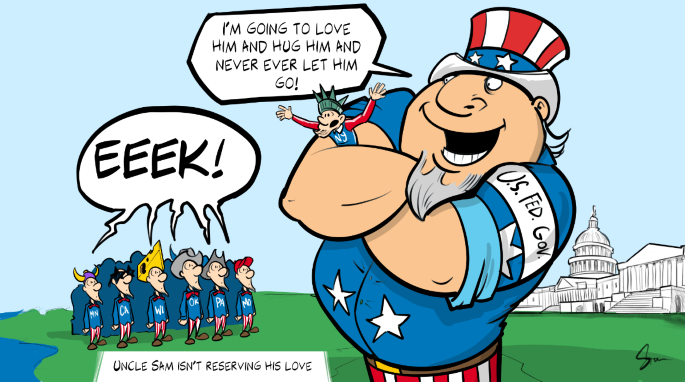Summary
In Part 2 of this lesson on federalism, students discuss a political cartoon, summarize governmental powers, and illustrate a given power. Learning will be extended by analyzing how the federal government influenced the states to change their drinking age. Finally, students complete a justified true or false activity on proposed laws to show their understanding of federalism.
Essential Question(s)
How is power shared in a federal system?
Snapshot
Engage
Students make observations about a political cartoon on governmental power.
Explore
Students analyze and discuss five governmental powers in groups.
Explain
Students illustrate a governmental power and then view them as a class and infer which power is portrayed in each illustration.
Extend
Students discuss how the federal government influences states’ rights.
Evaluate
Students analyze potential actions of the federal government and determine the proper authority of the actions.
Materials
Lesson Slides (attached)
Powers Readings handout (attached, one per group)
Powers Graphic Organizer handout (attached, one per student)
Expressed, Reserved, or Denied handout (attached, one per student)
Notebook paper (one per student)
Art supplies such as markers or colored pencils
Copy paper or butcher paper
Scissors (one per group)
Engage
10 Minute(s)
Use the attached Lesson Slides to guide the lesson. Display slide 3 as students enter the classroom. Using the Bell Ringer strategy, ask students to write down observations about the cartoon on notebook paper. Then, ask them to discuss their observations with another student before asking several students to share their thoughts with the whole class. Move through slides 4–5 to review the essential question and lesson objective with students.

Explore
20 Minute(s)
Place students into groups of five and pass out the attached Powers Readings handout to each group as well as a pair of scissors so that students can use the Jigsaw strategy to analyze the handout. Have students cut each page in half and distribute the five half-page readings to each member of the group. Pass out the attached Powers Graphic Organizer to each student. Display slide 6 and tell students to first read through the information and write down key points on their graphic organizer. Then have students share what they have written down to each member of the group.
Move to slide 7 and have students discuss the questions on the slide within their groups. The discussion questions on slide 7 are:
Why are the powers of the government divided?
How do the federal government and the states have to work together?
What potential struggles could come from the way power is divided between the federal government and the states?
After providing time for group discussion, ask for several students to share what they discussed. Display slides 8–9 and review the key aspects of each power. Have students add these to their graphic organizer now, if they do not already have them listed. Ensure that each student’s graphic organizer has been completed with each power’s characteristics before moving on.
Explain
40 Minute(s)
Move to slide 10 and introduce the Masterpiece Match-Up strategy to students. Provide each student or pair of students with their assigned power. Pass out or make art supplies available to students. Tell students they are going to create an illustration of the power they have been given. Have students brainstorm their illustration on scrap paper initially. Once they have decided on their illustration, provide each student with a piece of copy paper or butcher paper. Have students write their assigned number on the top right corner of their paper. Remind students not to share what power they are illustrating with other students.
Hang up each illustration around the classroom or in the hallway. Group the illustrations together by power so that there are five groups. Label each group A–E.
Display slide 11 and have students view each group of illustrations. Have students write A-E on a piece of notebook paper. Have students view the grouped illustrations. As they view the illustrations, ask them to write down which power they believe each group describes on their notebook paper.
After students have viewed the illustrations, have students return to their seats. Reveal each lettered group’s power and answer any questions students have about the different governmental powers. Consider adding labels to each group of illustrations after the lesson so that students can continue to observe them throughout the unit on federalism.
Extend
10 Minute(s)
Ask students which part of the government decides the legal drinking age, the federal government or each state? Let students share their thoughts. Tell students they are going to learn more about that issue and move to slide 12. Play the video for students: “South Dakota v. Dole | BRI’s Homework Help Series.”
After the video, move to slide 13 and ask students to talk with an elbow partner about the video using the reflection questions on the slide. After providing time for students to talk with a partner, ask several students to share what they discussed with their partner. Have a class discussion about the use of federal money to influence laws in the states.
Evaluate
10 Minute(s)
Display slide 14 and pass out the attached Expressed, Reserved, Denied handout to each student. Ask students whether or not they can pick ten out of the fifteen statements listed to answer. Students should read the statement and then decide if the federal government is given the power to complete the statement. After choosing, they should provide their reasoning, such as The statement listed is an item reserved for the states.
Collect the handouts and assess student understanding of the lesson content.
Resources
K20 Center. (n.d.). Bell Ringers and exit tickets. Strategies. https://learn.k20center.ou.edu/strategy/125
K20 Center. (n.d.). Jigsaw. Strategies. https://learn.k20center.ou.edu/strategy/179
K20 Center. (n.d.). Masterpiece match-up. Strategies. https://learn.k20center.ou.edu/strategy/2218
Bill of Rights Institute. (2020, November 10). South Dakota v. Dole | BRI's homework help series [Video]. YouTube. Retrieved March 16, 2023, from https://www.youtube.com/watch?v=1ROJjabQpO8


